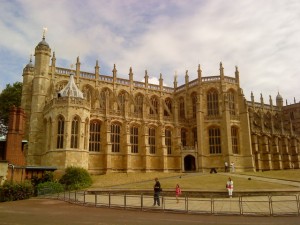 On 16th February 1547, King Henry VIII was buried in St George’s Chapel, Windsor Castle, according to the instructions given in his will:
On 16th February 1547, King Henry VIII was buried in St George’s Chapel, Windsor Castle, according to the instructions given in his will:
“We are content, and also by these presentes our last will and testament do will and ordeyn, that our body be buryed and enterred in the Quere of our college of Windesour, midway between the Statte [stalls] and the high Autarre [altar] and there to be made and sette, assoon as conveniently may be doon after our deceasse, by our executours, at our coste and charge, if it be not doon by us in our lief time, an honorable tomb for our bones to rest in, which is well onward, and almoost made therefor alredye, with a fayre grate about it; in which we will also, that the bones and body of our true and loving wief Queene Jane be put also; and that there be provided, ordeyned, made, and sett, at the coste and charge of us, or of our executours, if it be not doon in our
lief, a convenient Aulter, honorably prepared, and apparailled with all manner of thinges requisite and necessary for dayly masses, there to be sayd perpetuelly, while the world shall endure.”1
Unfortunately, the magnificent tomb in which Henry had planned to be laid to rest – a tomb which had actually been designed for Cardinal Wolsey – was not finished. In 1646 Parliament ordered that the ornaments of the tomb should be sold and the sarcophagus ended up being the tomb of Lord Horatio Nelson (1758-1805) and standing in St Paul’s Cathedral. Henry VIII’s and Jane Seymour’s remains are in a vault under the floor of the chapel, along with the remains of Charles I and an infant child of Queen Anne, the Stuart queen.
Here is an account of his burial:
“After remaining in the chapel all night, on the next day, about four o’clock, began the communion of the Trinity; when ‘after an offering of gold by the chief mourner, of the Knights of the Garter to St. George, and of the king’s hatchments, bannerols and banners, and other trophies, as also of the king’s horse richly trapped, came four gentleman ushers, and took away the pall of cloth of tissue (the picture being conveyed away before by six knights into the vestry); after which, sixteen strong yeomen of the guard took the coffin, and with five strong linen towels, which they had for their fees, let it into the vault (near unto the body of Queen Jane Seymour, his third wife), the grate being first taken away; then the Lord Chamberlain, the Lord Great Master, Mr. Treasurer, Mr. Comptroller, and the Sergeant Porter breaking their white staves upon their heads in three parts, as did likewise all the gentleman ushers, threw them into the grave, when Garter, assisted by the Bishops of Canterbury and Durham, declared the state and the name of the most godly prince their master, King Edward VI. Thus the funeral ending, the trumpet sounded in the rood-loft and the company departed.'”2
Today, there is a memorial slab marking Henry VIII’s resting place.
Notes and Sources
Image: St George’s Chapel, Windsor Castle © Copyright Andrew Abbott and licensed for reuse under this Creative Commons Licence.
- Pote, Joseph; Biggs, R; Parr, Richard; Smith, J (1749) The history and antiquities of Windsor Castle, and the Royal College, and Chapel of St. George… , p.56-7.
- Stoughton, John (1844) Notice of Windsor in Olden Times, David Bogue & W. Willmore p. 127-8.